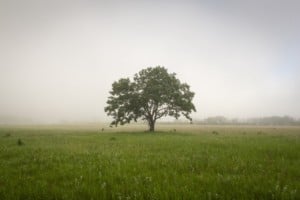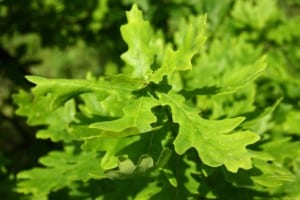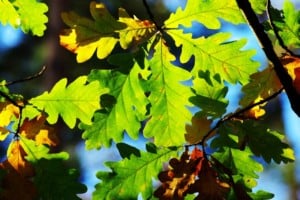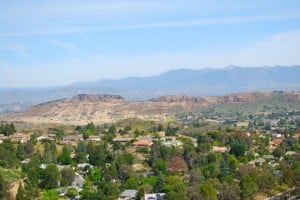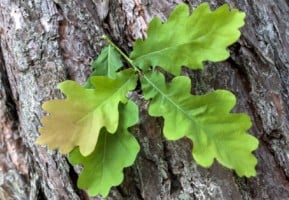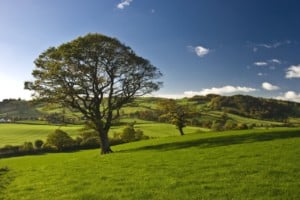Do you plan to grow Oak Trees in your garden? Well, you will be happy to know that there are multiple species of Oak Trees thriving in Canada due to its ideal soil and weather conditions. Read on to discover all about the different Oak varieties you can grow on Canadian soil!
Contents
- 1. White Oak (Quercus Alba)
- 2. Garry Oak (Quercus Garryana)
- 3. Swamp White Oak (Quercus Bicolor)
- 4. Northern Pin Oak (Quercus Ellipsoidalis)
- 5. Bur Oak (Quercus Macrocarpa)
- 6. Chestnut Oak (Quercus Michauxii)
- 7. Pin Oak (Quercus Palustris)
- 8. Chinkapin Oak (Quercus Muehlenbergii)
- 9. Dwarf Chinkapin Oak (Quercus Prinoides)
- 10. English Oak (Quercus Robur)
- 11. Northern Red Oak (Quercus Rubra)
- 12. Black Oak (Quercus Velutina)
Did you know that there are more than 600 species of Oak Trees? These trees are part of the Quercus Genus, which includes both evergreen and deciduous species. Oak Trees in Canada are impressively durable and can live for more than 200 years. They bear flowers in the spring and produce rounded to oval acorns in early fall.
Canada is blessed with a wide variety of native Oak Trees, including White Oak, Red Oak, Garry Oak, Bur Oak, and more. These trees have distinctive leaves, branches, and acorns. They have different colored barks with flaky ridges and large, ridged leaves that display varied fall hues.
Some Oak Tree varieties are quite popular in the timber industry as their durable wood is often used to produce flooring, furniture, posts, tool handles, ships, wagons, drums, and more. The wood is also split into thin strips to weave heavy baskets and other objects. It’s also used to produce barrels for whiskey, wine, and other alcoholic beverages.
The acorns produced by Oak Trees are a brilliant food source for wildlife, such as squirrels, deer, bears, small rodents, birds, raccoons, geese, and even cows! Moreover, some Oak Trees produce sweet acorns that you can pluck from the branches and eat straight away. However, many types of Oak Trees don’t produce an abundant crop of Acorns until they are at least 25 to 30 years old. So, you will have to be patient if you want to see this capped fruit growing on your Oak Tree.
Related: Maple trees in Canada
Here are some common types of Oak Trees that are widely grown in Canada:
1. White Oak (Quercus Alba)
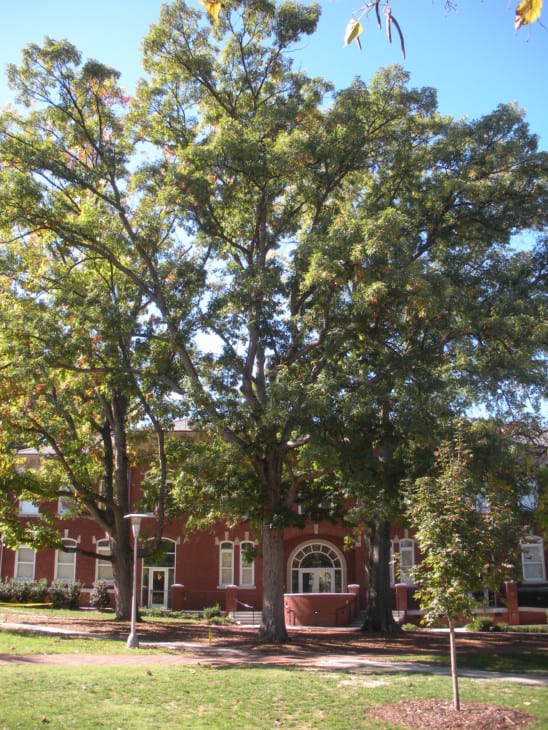
White Oak is a 50 to 80 feet tall, large, deciduous tree with a pyramidal to rounded crown. This wide-spreading tree features yellowish-green spring blossoms that give way to oval acorns with wart-scaled cups. It also has lobed, dark green leaves that turn brown and dark red in fall. White Oak thrives in acidic, well-drained, rich, moist soils and full sun.
2. Garry Oak (Quercus Garryana)
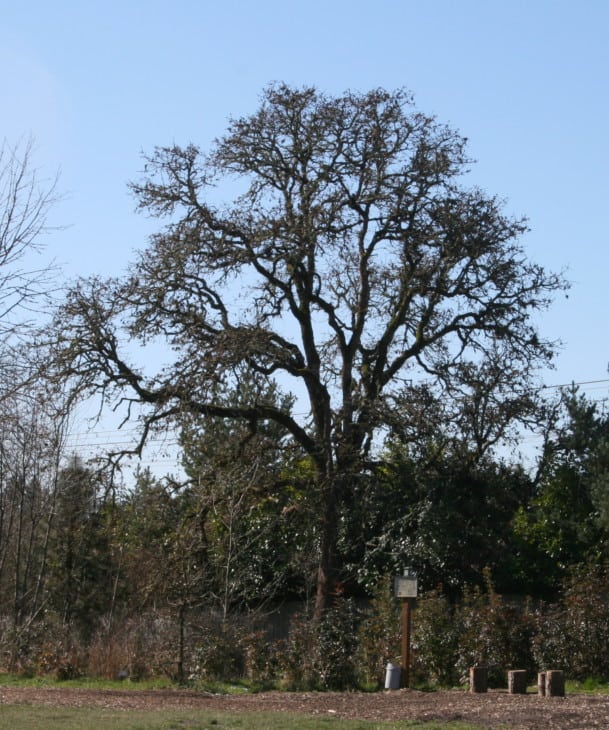
Garry Oak is a deciduous tree that can grow up to 80 feet tall. It features a light grey bark with thick ridges, large, rough branches, and shiny, green leaves. This slow-growing tree has dull yellow or brown fall foliage. Garry Oak is a drought-resistant, durable tree that grows well in well-drained, rich, moist soils and semi-shaded locations.
3. Swamp White Oak (Quercus Bicolor)
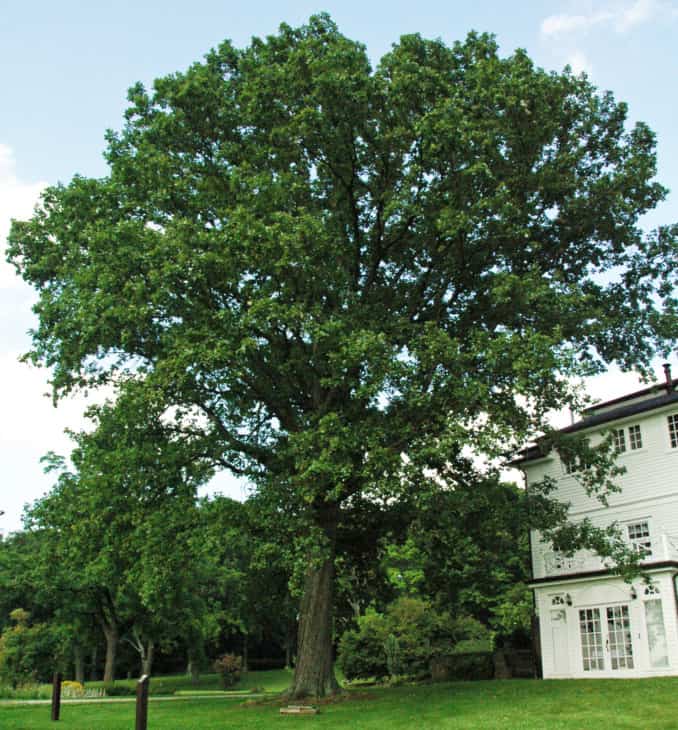
Swamp White Oak is a 50 to 60 feet tall, deciduous tree with a short trunk and a broad, rounded crown. It features shiny, dark green leaves with blunt edges and silvery-white bottoms. The foliage turns reddish-purple and yellow. This drought-resistant tree features insignificant flowers that give way to acorns. It thrives in acidic, wet, well-drained soils and full sun.
4. Northern Pin Oak (Quercus Ellipsoidalis)
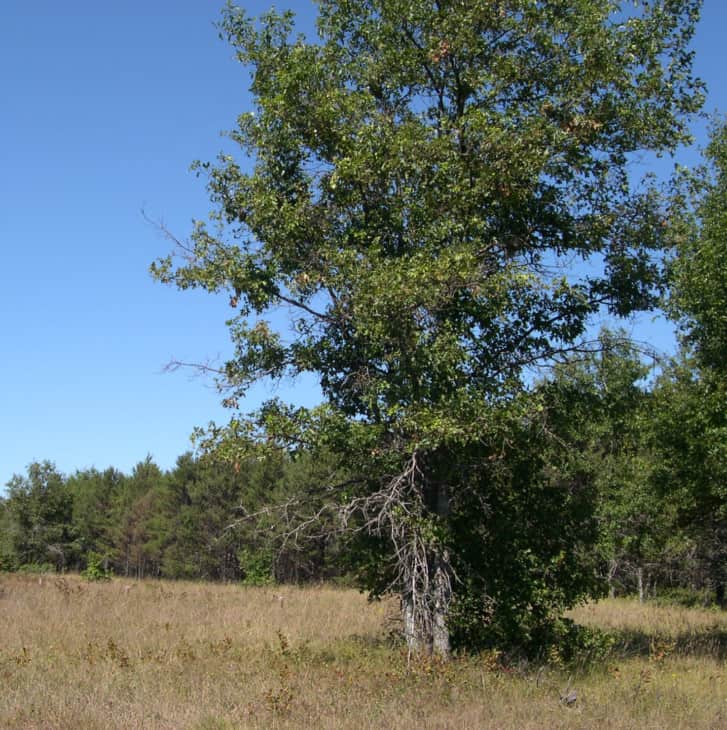
Also known as Jack Oak, Northern Pin Oak is a 50 to 70 feet tall, deciduous tree with a rounded crown. It features elliptic, dark green, deeply incised, bristle-tipped, dark green leaves that turn russet red in fall. It grows insignificant, yellowish-green blooms that turn into elliptic acorns with saucer-shaped cups. It has descending lower branches and ascending upper branches. This tree thrives in full sun and acidic, well-drained, medium moist soils.
5. Bur Oak (Quercus Macrocarpa)
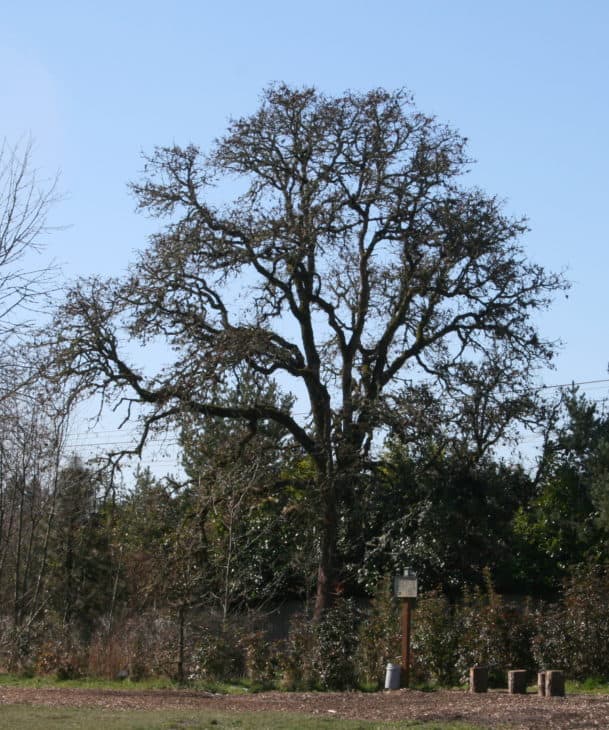
Bur Oak is a 60 to 80 feet tall, deciduous tree with a rounded, wide-spread crown. It features leathery, dark green, lobed leaves that turn yellowish-brown in fall. It also grows insignificant yellowish-green blossoms. The female flowers give way to oval acorns with fringed, mossy scaled cups. Bur Oak grows well in moist, well-drained loams and sunlit areas.
6. Chestnut Oak (Quercus Michauxii)
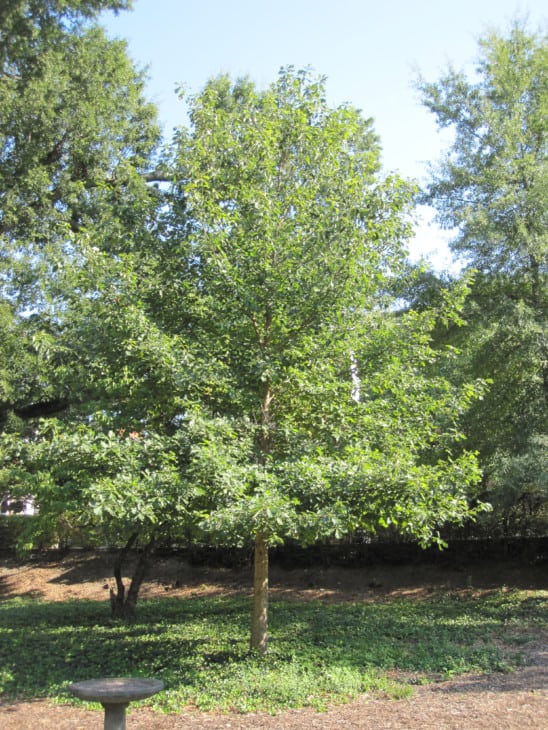
Chestnut Oak is a 40 to 60 feet tall, deciduous tree with a tight, rounded, narrow crown. It features obovate, wavy-margined, shiny, green leaves with grayish, hairy undersides. The foliage turns dark red in fall. Chestnut Oak features insignificant blossoms, followed by sweet-tasting acorns. This tree thrives in sunlit areas and moist, well-drained, acidic loams and sandy soils.
7. Pin Oak (Quercus Palustris)
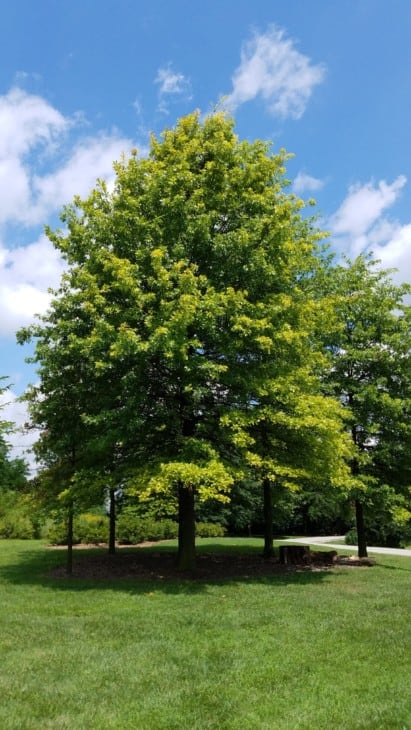
Pin Oak is a 50 to 70 feet tall, deciduous, Oak Tree with a broad, pyramidal crown. It features ascending upper branches, horizontal middle branches, and descending lower branches. This tree has rounded acorns with saucer-shaped cups. It is decked with glossy, dark green, lobed leaves that turn deep red in fall. Pin Oak grows well in moist, acidic, free-draining loams and sunlit areas.
8. Chinkapin Oak (Quercus Muehlenbergii)
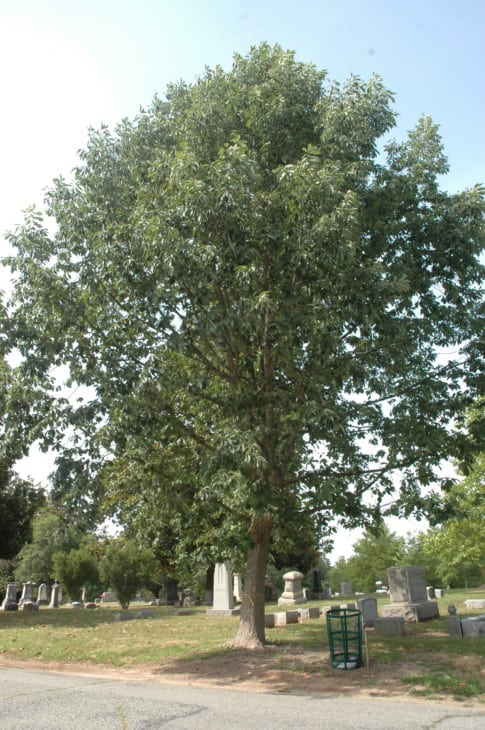
Chinkapin Oak is a 40 to 60 feet tall, deciduous tree with a globular, open crown. It features non-showy greenish-yellow blossoms that give way to small oval acorns with scaly cups. This tree is decked with narrow, shiny, oblong-lanceolate, coarse-edged, green leaves that turn yellow and brown in fall. Chinkapin Oak thrives in sunlit areas and well-drained, fertile, moist loams.
9. Dwarf Chinkapin Oak (Quercus Prinoides)
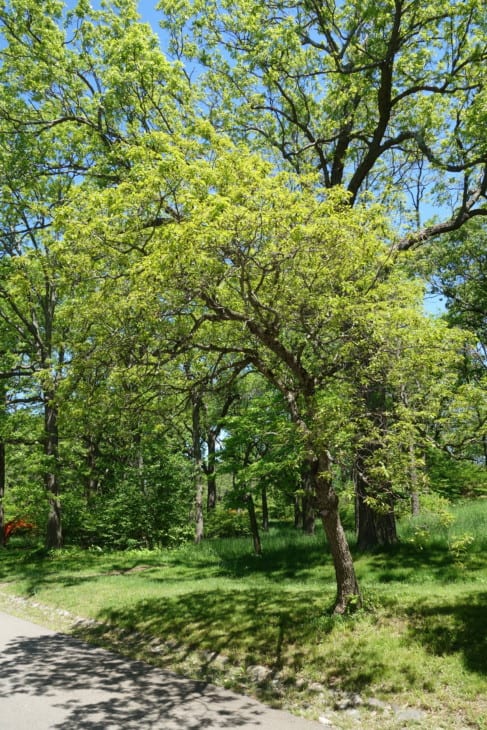
Dwarf Chinkapin Oak is a deciduous Oak that turns 13 to 20 feet tall. It features inconspicuous flowers that give way to smooth brown, oval acorns with a wart cap. It has leathery, yellow-green, elliptic-obovate, wavy-edged, serrate, lobed leaves with grayish-green undersides. The foliage turns yellow and copper in fall. Dwarf Chinkapin Oak grows well in free-draining, acidic, rich soils and full sun.
10. English Oak (Quercus Robur)
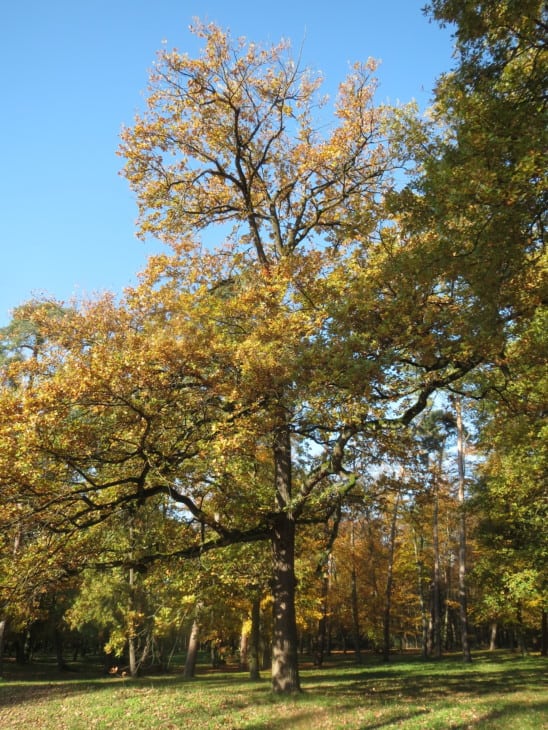
English Oak is a 40 to 70 feet tall, deciduous tree with a rounded, wide-spreading crown and a short trunk. It features short-stalked, lobed, dark green leaves with blue-green undersides. This tree produces insignificant, greenish-yellow blossoms that give way to oval acorns. English Oak thrives in sunlit areas and well-drained, moist loams.
11. Northern Red Oak (Quercus Rubra)
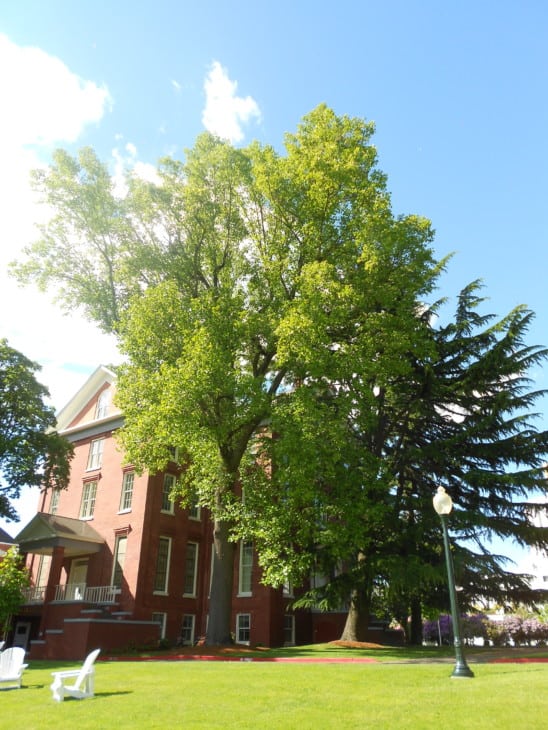
Northern Red Oak is a 50 to 75 feet tall, deciduous tree with an irregular, broad-spreading crown. It features dark, lustrous, lobed, sharp-edged leaves that turn brownish-red in fall. It yields acorns with flat, saucer-shaped cups. This durable tree grows well in fertile, acidic, medium moist, free-draining soils and sunlit areas.
12. Black Oak (Quercus Velutina)
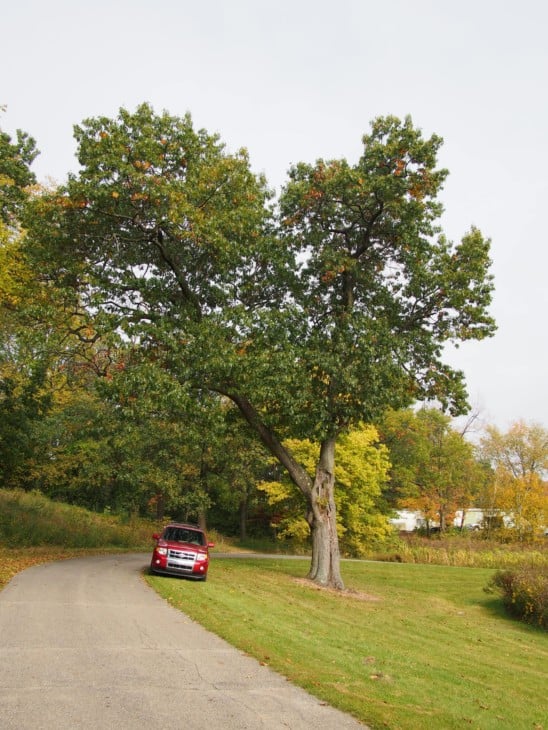
Black Oak is a 50 to 60 feet tall, deciduous tree with a spreading, globular crown and an almost black-hued bark. It features shiny, leathery, dark green, lobed, bristle-edged leaves that turn yellowish-brown and yellow to dull red in fall. Black Oak yields elliptic acorns with saucer-shaped cups. This tree thrives in well-drained, moist, organically rich soils and sunlit areas.


